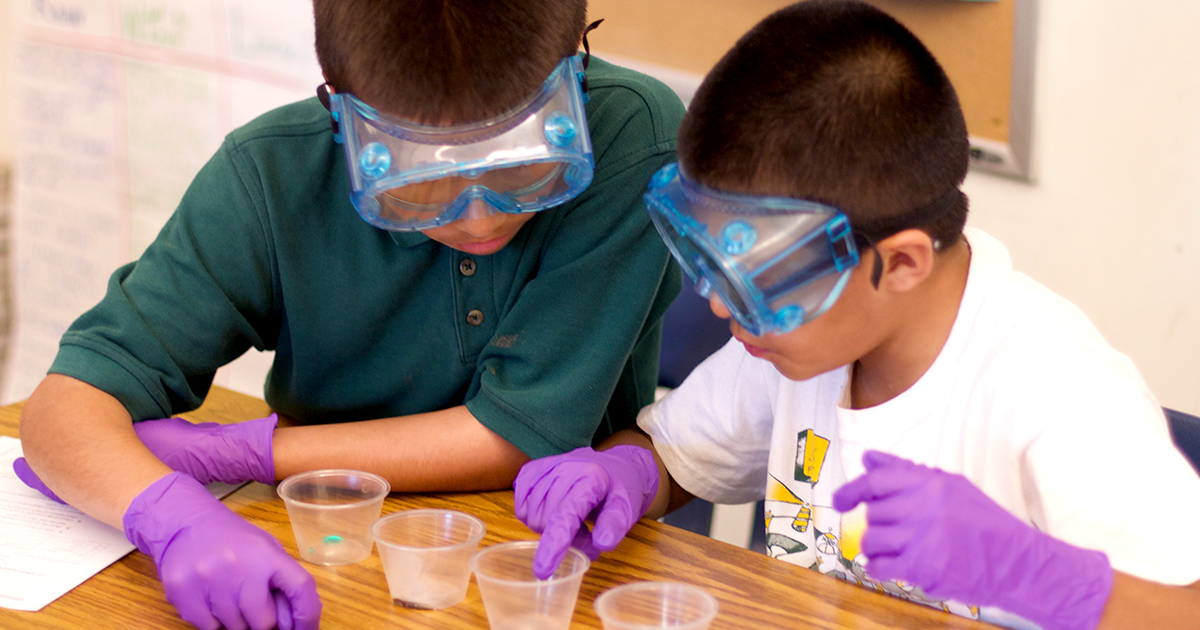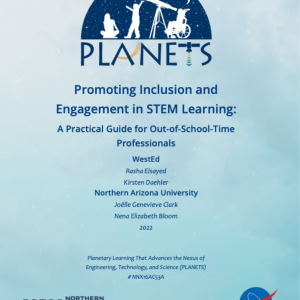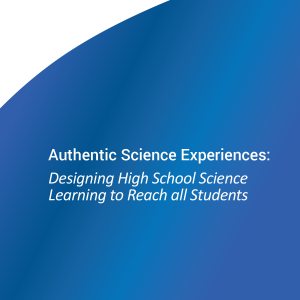Cultivating Cultural Competence: Building Affirming Science Learning Environments
Posted on

By Rasha ElSayed and Kirsten Daehler
This article first appeared on NextGenScience’s On the Same Wavelength blog and is posted here with permission.
Can you think of a time when you felt like an outsider or an “other” in the room? We have. As one of only a few girls in an AP Physics class, one of us remembers being told that girls don’t really understand physics, they just know how to get good grades. The other remembers, even as an educator, not having the language to participate in professional learning about “makers” and feeling that work is best left to the other educators present in the room.
It’s often an uncomfortable feeling. Some people describe difficulty concentrating. Others experience a hypervigilance as they observe the many ways they are different. As classrooms across the country are becoming increasingly racially and ethnically diverse and there are many ways for students to feel like an outsider, a key question for educators is: “How can we build affirming science learning environments?”
We recently conducted research to try to answer this question and released a practical guide for educators who teach STEM to diverse populations of youth—specifically, Indigenous youth, emergent multilingual learners, and learners experiencing differing physical and/or sensory abilities. The guide is based on interviews with out-of-school-time (OST) educators who work with these youth in STEM, along with a review of the research literature.
In this blog post, we share three strategies from the guide that offer a great place for teachers, administrators, and professional learning providers to begin this journey of building affirming classroom environments.
First, start with yourself—engage in conversations and reflections that surface your own cultural frames of reference and identify social learning behaviors that you notice are “expected” in different cultures [1][2][3]. One way to do this is to explore your own cultural assets and notice what stories are part of your culture. Such reflections can set the stage for conversations that dig into deeper questions. For example, you might ask yourself:
- What are my cultural assets?
- How might my cultural frame bias my instruction?
- What values do I hold about the meaning of self-motivation and effort?
- How have I been expected to interact with authority figures?
- Was the authority of others around me assumed or earned?
- What behaviors do I think my students should exhibit when collaborating or when participating in a classroom discussion?
Surfacing these questions for ourselves can be a tremendous step forward in helping us reflect on our own reactions to students’ behaviors and offer alternative explanations and interpretations of classroom behaviors that might be problematic, such as talking across a learning space or lack of eye contact This can offer a powerful pathway toward building affirming classroom environments, as this understanding broadens our body of explanations of students’ behaviors and interactions.
Second, strive to view every student as a competent and thriving individual, rather than focusing on “helping students to cope with challenges.” This is likely far more easily said than done, especially if your own self-identity includes being supportive and helpful to those around you. We found the following four perspectives to be concrete ways to make this shift [4]:
- Show interest in what the student thinks, feels, and wants;
- Show appreciation for what is great about a student’s life, their aspirations, joys, and dreams;
- Be curious about how you can be of service to a learner and what paths you can take together; and
- Be open to reciprocal relationships with learners in which you think about how each of your lives can be enriched by your relationship with different students.
While taking a competency viewpoint certainly benefits all students (and their teachers), this perspective can be especially important when working with students experiencing physical and sensory disabilities. When we examine our own underlying assumptions towards varying abilities, it may help to surface some of these perspectives that may interfere with providing an inclusive learning environment. One educator we spoke with shared with us their experience when working with a student with visual disability:
During the NASA roads program, my students had to keep a drone flying up for 10 seconds. We had our youngest student who was in 4th grade. The 4th grade student was excited and wanted to try, and I was really not sure he was going to do this, and he landed it on a bull’s eye. I try not to put a ceiling on my expectations! This student had a visual impairment, but he could hear what he was flying. He had so much experience using a controller. He was listening to where the drone was. My advice to educators is to step back when you want to go and help them. Trust that the student can do it.
Third, get to know your students and the communities you work with. We noticed that getting to know cultures that are different from your own might be challenging, especially if you work with more heterogeneous cultural spaces. In these circumstances, introducing a “Get to Know You” type of activity to use with students and their families can build your own awareness of students’ family and community cultural backgrounds.
There are many ways to learn about cultural context, such as seeking out videos and readings about Indigenous histories and speaking with family members or community elders to support the learning of Indigenous youth. Also, leaning on students themselves to share their values while experiencing STEM activities and learning to appreciate the different perspectives that students bring in can be effective strategies.
For example, one educator shared that they paused their hike during camp to explore with one of their Navajo youth the sacred value of toads. Her student shared that “toad” means to them a “grandfather” and ancestor, so it is sacred to them. The educator realized sometimes it’s helpful to let go of what they had planned for the lesson because what students can learn from each other can sometimes be far more than what they can learn from the curriculum.
Educators can also apply the same strategy with working with students experiencing physical and/or sensory disabilities. It can be eye-opening to ask a learner to describe the culture that exists around the way in which they perceive and navigate the world. Asking person-to-person is a way of acknowledging and valuing the social and cultural models that exist among disabled youth. Working to understand learners’ frames of reference helps us take actions that build affirming science learning environments.
There is much to be gained by first noticing and then meaningfully working to engage with students around the language and cultural assets they bring to class. When students feel seen and valued, when they don’t feel like an “other,” they become more engaged in science learning. When students (and their peers) recognize the value they bring to the classroom, they are more willing to share their perspectives about diverse ways in which their communities define and construct knowledge. This diversity of perspectives can add richness to conversations, offer varied solutions to problems, and in turn support every student (and teacher) in developing their own positive cultural identities and sense of belonging in STEM.
To learn more, read Promoting Inclusion and Engagement in STEM Learning: A Practical Guide for Out-of-School-Time Professionals.
Rasha ElSayed is a Research Associate with the Science and Engineering group at WestEd. She works on research and evaluation projects that promote science participation to diverse youth groups.
Kirsten Daehler is the Director of Science and Engineering at WestEd, and founder of Making Sense of SCIENCE. She works with regional and statewide leaders to build local capacities, further STEM education, and benefit thousands of teachers each year. She is also the Co-PI on the NASA PLANETS project and other projects related to data fluency and place-based education.
References
[1] Dray, B. J., & Wisneski, D. B. (2011). Mindful reflection as a process for developing culturally responsive practices. Teaching Exceptional Children, 44(1), 28–36.
[2] Smith, D., Fisher, D., & Frey, N. (2021). Removing labels, grades K–12: 40 techniques to disrupt negative expectations about students and schools. Corwin Press.
[3] Hammond, Z. (2015). Culturally responsive teaching and the brain: Promoting authentic engagement and rigor among culturally and linguistically diverse students. Corwin Press.
[4] Nevin, A., Smith, R. M., & McNeil, M. (2008). Shifting attitudes of related service providers: A disability studies & critical pedagogy approach. International Journal of Whole Schooling, 4(1), 1–12.


